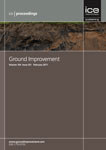
Proceedings of the Institution of Civil Engineers-Ground Improvement
Scope & Guideline
Innovating Civil Engineering Through Groundbreaking Research
Introduction
Aims and Scopes
- Ground Improvement Techniques:
The journal covers a wide range of ground improvement techniques including mechanical, chemical, and biological methods aimed at enhancing soil properties for construction purposes. - Innovative Materials and Methods:
Research on novel materials such as biopolymers, geopolymers, and waste materials is prevalent, focusing on their applications in stabilizing soils and enhancing structural integrity. - Experimental and Numerical Analysis:
The journal emphasizes both experimental studies and numerical modeling approaches to understand soil behavior under various conditions, including cyclic loading, shear strength testing, and consolidation. - Sustainability in Ground Improvement:
There is a consistent focus on sustainable practices, including the use of recycled materials and environmentally friendly methods for soil stabilization. - Field Studies and Case Investigations:
The publication includes real-world applications and case studies that provide insights into the practical implementation of ground improvement techniques in various geotechnical contexts.
Trending and Emerging
- Bio-Stabilization Techniques:
The use of biological methods for soil stabilization, such as biocementation and biochar amendments, is emerging as a key area of research, reflecting a growing interest in sustainable engineering practices. - Geopolymer and Eco-Friendly Materials:
Research on geopolymer stabilization and other eco-friendly materials is trending, showcasing advancements in sustainable construction materials that reduce environmental impact. - Advanced Numerical Modeling:
An increase in the application of advanced numerical modeling techniques, such as artificial intelligence and machine learning, is evident, facilitating more accurate predictions of soil behavior. - Impact of Waste Materials:
The exploration of waste materials, such as industrial byproducts and recycled materials, for ground improvement is gaining momentum, aligning with global sustainability goals. - Innovations in Ground Improvement Practices:
There is a growing emphasis on innovative practices and hybrid systems, such as combining different ground improvement methods to enhance performance and reliability.
Declining or Waning
- Traditional Soil Stabilization Methods:
Conventional methods such as lime or cement stabilization appear to be less frequently published, as newer, more innovative approaches gain traction in the field. - Purely Theoretical Models:
There is a noticeable reduction in purely theoretical studies that do not incorporate experimental validation or practical applications, reflecting a shift towards applied research. - Focus on Conventional Materials:
Research centered on traditional materials without sustainable or innovative enhancements is becoming less common, as the field increasingly prioritizes eco-friendly alternatives.
Similar Journals

Transportation Infrastructure Geotechnology
Exploring the Nexus of Geotechnology and Civil Engineering.Transportation Infrastructure Geotechnology, an esteemed journal published by SpringerNature, serves as a vital platform in the fields of Civil and Structural Engineering, Environmental Engineering, Geotechnical Engineering, and Transportation. Established in 2014 and spanning a decade of significant scientific discourse, this journal has gained recognition for its robust contribution to the understanding of the interplay between geotechnical processes and transportation infrastructure. With an impactful Q2 ranking in multiple categories—including Civil and Structural Engineering and Environmental Engineering—it emphasizes innovative research and practical applications globally. Researchers and professionals can explore critical topics that influence infrastructure sustainability, safety, and efficiency. Although it operates under a subscription model, its affiliation with SpringerNature ensures rigorous peer-review and high-quality publications, making it an indispensable resource for academics and industry experts alike.

Journal of the Korean Geosynthetic Society
Advancing Geosynthetic Innovation for a Sustainable FutureJournal of the Korean Geosynthetic Society, published by the Korean Geosynthetic Society, is an essential platform dedicated to advancing the field of geosynthetics, a critical area of civil engineering and environmental science. With a focus on innovative materials and applications that contribute to sustainable infrastructure and environmental protection, this journal actively encourages submissions from researchers and practitioners worldwide. Although currently not indexed by Impact Factor systems, the journal's commitment to rigorous peer-review ensures the dissemination of high-quality research and practical insights that drive the field forward. The journal publishes a range of articles including experimental studies, theoretical analyses, and case studies, making it a valuable resource for engineers, researchers, and students alike, fostering collaboration and knowledge sharing within the geosynthetic community. The journal is accessible at http://www.kgs.org. Join us in shaping the future of geosynthetic technology through your contributions!
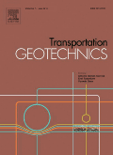
Transportation Geotechnics
Bridging the Gap Between Geotechnics and Mobility.Transportation Geotechnics is a premier academic journal published by Elsevier, focusing on the intersection of geotechnical engineering and transportation systems. With an impressive impact factor and categorized in the Q1 quartile across multiple disciplines including Civil and Structural Engineering, Geotechnical Engineering, and Transportation, this journal stands as a vital resource for researchers and practitioners alike. It covers a broad spectrum of topics ranging from soil behavior in transport contexts to innovative materials and methods that enhance infrastructure stability and performance. As an essential platform fostering knowledge dissemination, Transportation Geotechnics enables contributors to share their groundbreaking findings while providing readers with access to cutting-edge research and reviews from 2014 to 2024. Its illustrious Scopus rankings place it prominently in the global research landscape, making it an indispensable tool for students, professionals, and academics dedicated to advancing the field.
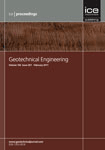
PROCEEDINGS OF THE INSTITUTION OF CIVIL ENGINEERS-GEOTECHNICAL ENGINEERING
Exploring Innovative Solutions in Earth SciencesPROCEEDINGS OF THE INSTITUTION OF CIVIL ENGINEERS-GEOTECHNICAL ENGINEERING, published by Emerald Group Publishing Ltd, is a prestigious journal that serves the dynamic field of geotechnical engineering and broader earth sciences. With an ISSN of 1353-2618 and an E-ISSN of 1751-8563, this journal has established itself as a vital resource for researchers, professionals, and students alike, offering insights into innovative practices and developments within the geotechnical domain. It ranks within the Q2 category for Earth and Planetary Sciences and Geotechnical Engineering as of 2023, demonstrating its significant impact and relevance in these fields. Given its comprehensive scope from 1994 to 2024, the journal provides a platform for high-quality research articles, case studies, and technical notes, although it presently does not offer open access options. Researchers seeking to publish their work will find this journal an essential venue for reaching an audience deeply invested in the advancement of geotechnical methodologies and solutions.
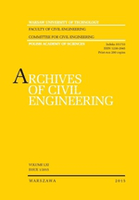
Archives of Civil Engineering
Empowering Engineers Through Quality ResearchArchives of Civil Engineering is a premier academic journal published by POLISH ACAD SCIENCES, dedicated to advancing the field of civil and structural engineering. Established in 1996, this open-access journal has been pivotal in disseminating high-quality research and innovation in engineering practices, particularly since adopting open access in 2010. With an ISSN of 1230-2945 and E-ISSN of 2300-3103, it enjoys a notable reputation, currently ranked in Q3 of the Civil and Structural Engineering category for 2023, reflecting its considerable contribution to scholarly content in the discipline. The journal caters to a diverse audience of researchers, professionals, and students, providing them with a platform to share and access essential findings. Its commitment to high academic standards is underscored by its ranking in Scopus, where it stands at Rank #265/379. Located in Warsaw, Poland, the journal aims to promote international collaboration and foster knowledge exchange in civil engineering, making it an indispensable resource for anyone involved in this dynamic field.
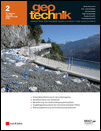
Geotechnik
Advancing Geotechnical Knowledge for a Sustainable FutureGeotechnik, published by ERNST & SOHN, is a prestigious journal in the field of Geotechnical Engineering and Engineering Geology. With its roots tracing back to 1982 and regular publications since then, it provides a vital platform for researchers, practitioners, and students to share and disseminate cutting-edge findings, methodologies, and techniques. The journal's ISSN is 0172-6145 and the E-ISSN is 2190-6653. Notably, it has achieved a commendable Q3 category ranking in 2023, reflecting its contribution to advancing knowledge in its field, as indicated by its Scopus rank of #171 out of 229 in the Earth and Planetary Sciences category. Although it does not offer open access, the journal remains integral for professionals aiming to stay informed about current trends and breakthroughs in geotechnics. Geotechnik strives to underpin its objectives of fostering quality research and encouraging innovation within the geotechnical community, ensuring it remains a crucial resource for all stakeholders involved.

Geomechanics and Engineering
Bridging Theory and Practice in Engineering GeologyGeomechanics and Engineering is a premier journal published by TECHNO-PRESS that delivers high-quality research in the fields of civil and structural engineering, as well as geotechnical engineering and engineering geology. With an ISSN of 2005-307X and an E-ISSN of 2092-6219, this journal serves as a significant repository of innovative methodologies, case studies, and theoretical advancements. Located in South Korea, Geomechanics and Engineering is indexed in Scopus, where it boasts a commendable ranking of #100 out of 379 in Civil and Structural Engineering and #69 out of 229 in Geotechnical Engineering and Engineering Geology, reflecting its impact with substantial percentile rankings of 73rd and 70th, respectively. Over its converged years from 2009 to 2024, the journal aims to advance the understanding of geomechanical phenomena and their application in engineering, making it an essential read for researchers, professionals, and students committed to solving today's pressing engineering challenges.
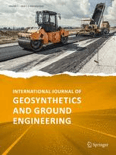
International Journal of Geosynthetics and Ground Engineering
Unlocking the potential of geosynthetics for a sustainable tomorrow.International Journal of Geosynthetics and Ground Engineering, published by SPRINGER INT PUBL AG, stands as a vital resource for the fields of civil engineering and materials science, particularly in the study and application of geosynthetics. With an ISSN of 2199-9260 and E-ISSN 2199-9279, this journal has established itself in the academic community, achieving a commendable position in Q2 category rankings for both Civil and Structural Engineering and Polymers and Plastics as of 2023. It ranks 134th in civil engineering and 77th in polymer science within Scopus, reflecting a respectable impact factor that emphasizes its influence in these disciplines. The journal covers a diverse range of topics, from innovative geosynthetic materials to groundbreaking engineering applications, and aims to foster an environment of collaboration and knowledge dissemination among researchers, professionals, and students. With its scope extending from 2015 to 2024, the International Journal of Geosynthetics and Ground Engineering is committed to pushing the boundaries of research and development in sustainable engineering practices, making it an essential publication for those interested in the future of geosynthetic technology.

Innovative Infrastructure Solutions
Pioneering Research for Cutting-Edge Infrastructure Development.Innovative Infrastructure Solutions is a leading academic journal published by Springer International Publishing AG, focusing on pioneering advancements in the fields of building and construction, civil and structural engineering, and environmental engineering. With an impact factor that reflects its significant role in the academic community, this journal serves as a vital platform for researchers, professionals, and students to disseminate groundbreaking studies and novel methodologies spanning diverse engineering disciplines. Since its inception in 2016, Innovative Infrastructure Solutions has steadily positioned itself within the Q2 category across several fields, including geotechnical engineering and engineering geology, as recognized in the 2023 quartiles. This reputable journal, accessible from Switzerland, not only emphasizes collaboration and knowledge exchange but also empowers innovators in infrastructure development globally. Whether you're contributing to a research project or seeking the latest findings, Innovative Infrastructure Solutions remains essential for anyone invested in advancing sustainable infrastructure solutions.

International Journal of GEOMATE
Connecting theory and practice in geotechnical and environmental engineering.The International Journal of GEOMATE, published by GEOMATE INT SOC based in Japan, is a pivotal resource for scholars and practitioners in the fields of Building and Construction, Environmental Engineering, Geotechnical Engineering, and Soil Science. Established in 2011 and continuing to set the standard in its focus areas, this journal serves as a platform for innovative research and practical applications, with contributions that significantly enhance the understanding and development of sustainable engineering practices. With its current classification in the Q3 quartile across multiple categories, it strives to disseminate critical knowledge and foster dialogue among a diverse audience, including researchers, industry professionals, and students. Though operating under a traditional subscription model, the journal's emphasis on rigorous peer review and high-quality publications ensures a substantial impact factor, further reinforcing its reputation in academia. Spanning from 2011 to 2024, the International Journal of GEOMATE invites contributions that advance the knowledge frontier and address contemporary challenges in engineering and environmental science.